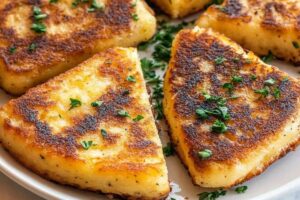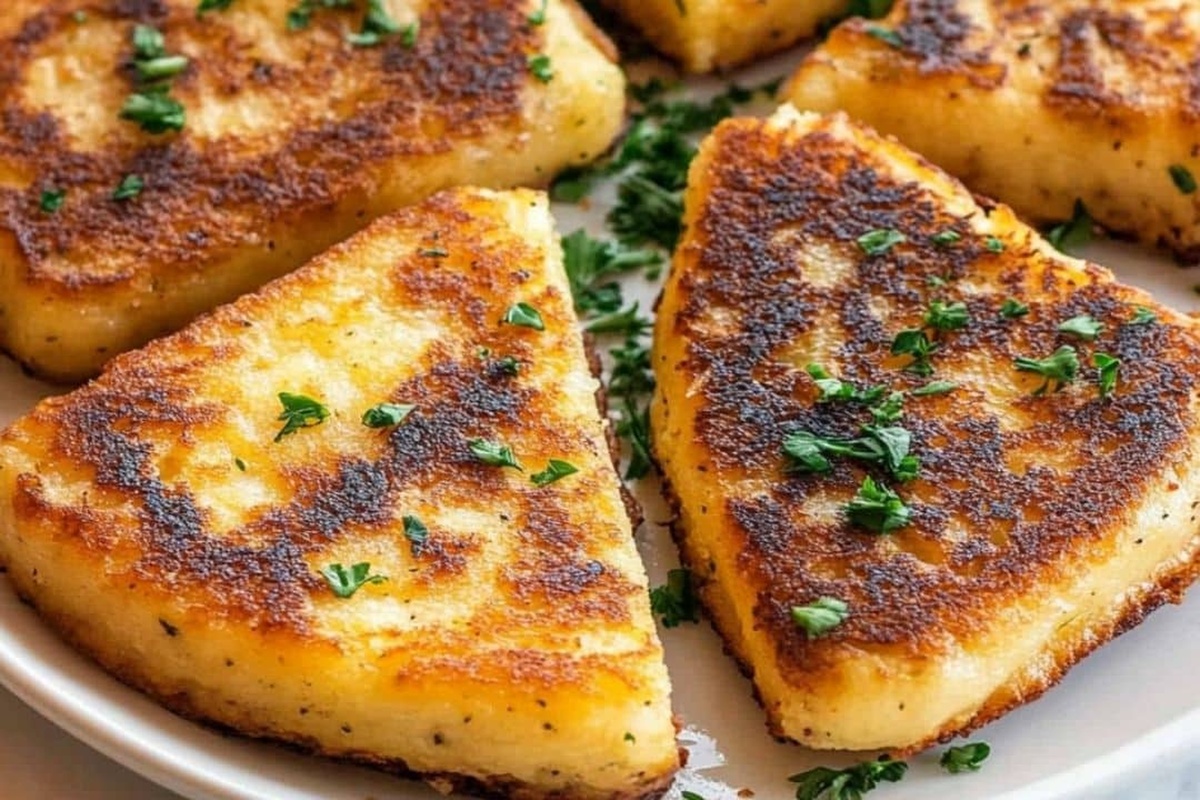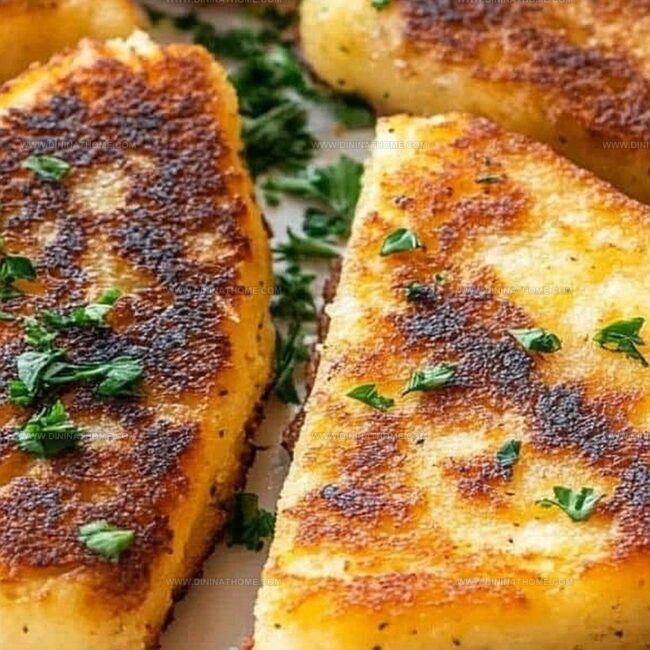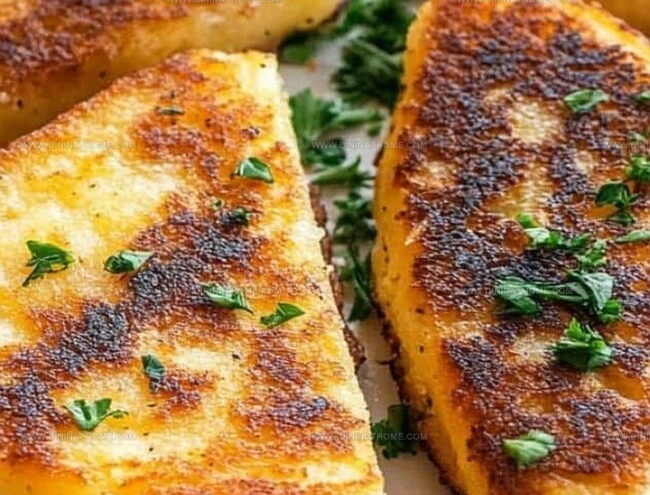The Fluffiest Irish Potato Cakes Recipe: Golden & Homestyle
Crispy golden Irish potato cakes might just become your weekend breakfast obsession.
potato lovers appreciate these delectable treats that blend rustic comfort with simple ingredients.
Humble pantry staples transform into something magical with minimal effort.
Regional kitchens across ireland have perfected this scrumptious recipe through generations of careful preparation.
Crisp edges and soft centers make these cakes irresistibly satisfying.
Compact and portable, they work beautifully as a quick snack or hearty meal companion.
You’ll want to savor every delicious bite of these traditional treasures.
Irish Potato Cakes That Define Simple Comfort
Irish Potato Cakes (Potato Farls) Ingredients
Potato Base:Fat and Seasoning:Cooking Essentials:Potato Cakes Old-Fashioned Steps
Step 1: Prepare Potato Mixture
In a large mixing bowl, blend together mashed potatoes, all-purpose flour, melted butter, and salt.
Work the ingredients gently with your hands or a wooden spoon until they come together into a soft, pliable dough.
If the mixture feels too sticky, gradually sprinkle in small amounts of additional flour to achieve the right consistency.
Step 2: Roll Out the Dough
Dust your work surface with a light coating of flour.
Transfer the potato dough onto the surface and use a rolling pin to flatten it into a smooth, even circle about quarter-inch thick.
Take your time to create an uniform thickness for even cooking.
Step 3: Shape the Potato Farls
Using a sharp knife or pizza cutter, divide the flattened dough into quarters, creating four triangular-shaped potato farls.
These traditional Irish bread pieces should look like neat, rustic wedges.
Step 4: Cook on Griddle or Skillet
Heat a cast-iron skillet or griddle over medium heat.
No need to add extra oil or butter.
Carefully transfer the potato farls onto the hot surface.
Cook each side for approximately 3-4 minutes until they develop a beautiful golden-brown color and crispy exterior.
Step 5: Serve and Enjoy
Remove the potato farls from the heat and place them on a warming plate.
Serve immediately while they’re hot and crispy.
These traditional Irish potato cakes pair wonderfully with breakfast dishes, can be topped with butter, or enjoyed alongside eggs and bacon.
Potato Farls Tips for Irish Breakfast Favorites
Irish Potato Cakes Leftovers
What to Serve With Irish Potato Cakes
Irish Potato Cakes Traditional Takes
FAQs
Potato farls are a classic part of an Ulster fry breakfast in Northern Ireland, often served alongside bacon, eggs, and soda bread.
No, you can use any type of starchy potatoes like Russet or Yukon Gold that mash well and create a smooth texture.
Yes, you can prepare the dough in advance and refrigerate it for up to 24 hours before cooking, making meal prep easier.
Traditional potato farls contain wheat flour, so they are not gluten-free. However, you can substitute with gluten-free flour for a similar result.
Print
Irish Potato Cakes Recipe
- Total Time: 20 minutes
- Yield: 4 1x
Description
Potato farls bring Ireland’s hearty culinary heritage to life with crispy, golden edges and rich, buttery flavor. Homemade potato cakes offer comfort and warmth you’ll savor with each delightful bite.
Ingredients
Main Ingredients:
- 2 cups mashed potatoes
- 1 cup all-purpose flour
Seasoning:
- 1/2 teaspoon salt
- 1/2 teaspoon baking powder
Fats/Cooking Ingredients:
- 2 tablespoons melted butter
- 1 tablespoon butter (for frying)
Instructions
- Thoroughly combine mashed potatoes, flour, melted butter, and salt in a mixing bowl, creating a cohesive dough that holds together without crumbling.
- If the mixture appears overly adhesive, gradually incorporate additional flour, ensuring the consistency remains pliable and manageable.
- Transfer the dough onto a lightly floured surface, gently kneading for a minute to develop a smooth texture and ensure even ingredient distribution.
- Roll out the dough into a circular shape approximately ¼ inch thick, maintaining an even surface for uniform cooking.
- Using a sharp knife or pastry cutter, divide the rolled dough into quarter sections, creating traditional potato farl triangles.
- Heat a cast-iron skillet or heavy griddle over medium-low heat, lightly greasing the surface with butter or oil to prevent sticking.
- Carefully transfer the potato cake triangles onto the heated surface, cooking each side for 3-4 minutes until a golden-brown crust forms and the interior remains tender.
- Watch carefully to prevent burning, adjusting heat as needed to achieve a crisp exterior and soft interior.
- Remove the potato farls from the skillet, placing them on a wire rack or plate lined with paper towels to absorb excess moisture.
- Serve warm alongside breakfast items like eggs, bacon, or as a standalone comfort food, optionally accompanied by additional butter or fresh herbs.
Notes
- Flour your work surface generously to prevent sticking and ensure smooth rolling of the potato dough.
- For extra crispiness, use cold mashed potatoes from the refrigerator and make sure they are well-drained to remove excess moisture.
- Consider adding finely chopped fresh herbs like chives or parsley to enhance the flavor profile and add a subtle green color.
- Gluten-free option: Replace all-purpose flour with a gluten-free flour blend or almond flour for those with wheat sensitivities.
- Prep Time: 5 minutes
- Cook Time: 15 minutes
- Category: Breakfast, Snacks
- Method: Frying
- Cuisine: Irish
Nutrition
- Serving Size: 4
- Calories: 210
- Sugar: 0 g
- Sodium: 160 mg
- Fat: 9 g
- Saturated Fat: 5 g
- Unsaturated Fat: 4 g
- Trans Fat: 0 g
- Carbohydrates: 30 g
- Fiber: 2 g
- Protein: 4 g
- Cholesterol: 20 mg




Emily Harper
Nutrition Consultant & Recipe Analyst
Expertise
Healthy Recipe Modification, Nutritional Analysis & Meal Planning, Global Cuisine & Dietary Adaptations
Education
School: French Pastry School, Chicago, IL
Program: L’Art de la Pâtisserie
Focus: Intensive training in traditional French pastry techniques, baking theory, and confectionery arts.
Emily’s journey started in a pastry kitchen but took a detour into the world of health and flavor science.
Graduating from the French Pastry School and studying nutrition opened her eyes to a new mission: making healthy food taste like something you’d actually crave.
At Dining At Home, Emily’s the go-to for smart, feel-good recipes that don’t trade flavor for nutrition.
She’s all about adding a fresh spin on old favorites and finding small ways to make everyday meals a little brighter.
Outside of the kitchen, Emily is most at home walking forest trails, testing plant-based recipes, or sharing a picnic under a wide-open sky.